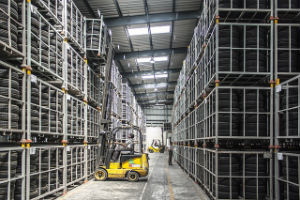You have no items in your shopping basket.
Key Things to Consider When Planning LED Lights For Your Warehouse

Running a warehouse takes a lot of planning and multitasking. In order to deliver stock and items on time, your processes need to be clear and efficient, and your staff need to be well trained and handle items safely. You may have decided that LED lights are a sensible investment for the business. No doubt, better lighting will improve many things - as well as save money on running costs. There are some key things to consider when planning an LED installation. Read on to find out about some things you may not have considered.
Plan the Lighting Layout Beforehand
LED lights are perfect for many reasons and are especially ideal for warehouses; however, unlike halogen lights, LED lights light an area differently. Ensure that you have planned the new layout accordingly before having anything installed. You want to get the best use of the illumination, so having LED lights high in corners is simply a waste of resources. Maintenance will be difficult and cost you more in lost time than if you had planned the layout in advance.
Make Allowances for Forklift Drivers
LED lights operate differently to halogen and other traditional lights. LED lights are made up of many small points of light, which can be very bright for those who look directly at them. It is therefore imperative to ensure the comfort of staff and those most likely to be looking, such as forklift drivers. You may need to consider having a lower wattage for these LED lights positioned over gangways. A way around this is to have dimmable LED lights so the lighting level can be adjusted.
Plan for Different Lighting Scenarios
Depending on the setup of your warehouse, you may have skylights that allow a lot of natural light in. You should plan for times of the day and year that you won’t need lighting, such as overnight or when you may need reduced lighting levels. This will help you to decide whether you need dimmable lighting (which is a key advantage of LED lights over non-LED lights). Motion sensors are also a viable option for certain places that only require light when there are staff moving around.
Take into Account Maintenance and Accessibility
LED lights have up to 50,000 hours of light, which has many benefits for a warehouse; however, there is still the issue of maintenance. Whilst in theory, LED lights can run for many years, accessibility is still hugely important. It is advised that you have a plan to allow easy access to change bulbs and perform routine checks on the LED lights. Having this as a recorded process will also help with the health and safety aspects of your business, as well as plan for minimal disruption.
Think about the Cost-Saving Implications
LED lights are a large investment for any business, but there is funding available for businesses, especially those that are council-run. The installation fees can seem steep, but you should consider the money that can be saved over the coming years. Such savings can be put back into the business and used to improve other processes.
Summary
LED lights are a lot to consider for your business, but taking these points into account will ensure that you get the layout and style of LED lights that your business needs. LED lights are the future of lighting - it just takes some planning to get them right.
